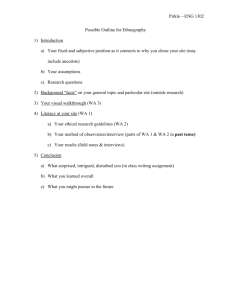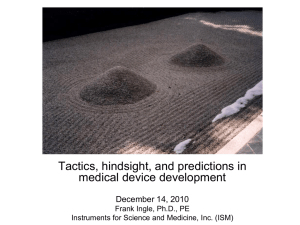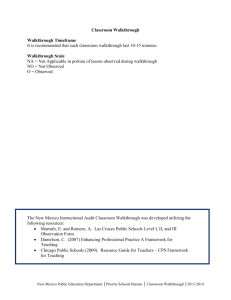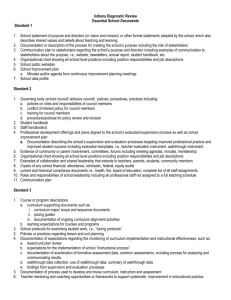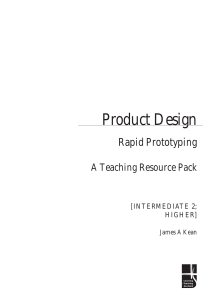Service walkthroughs to support service development Abstract
advertisement
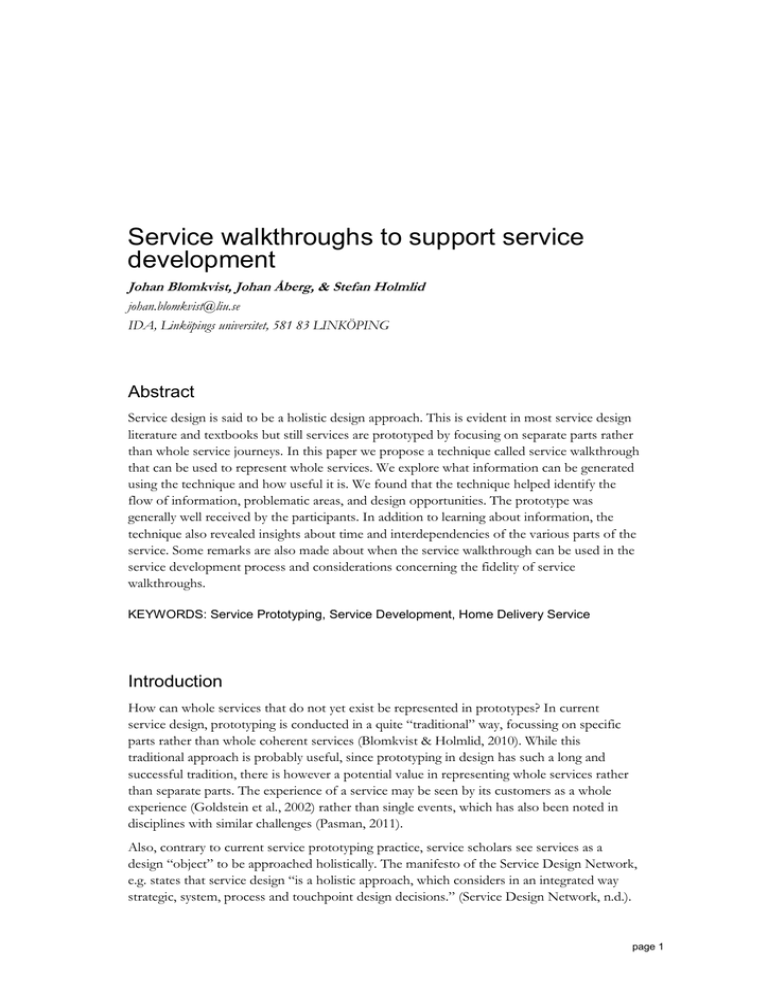
Service walkthroughs to support service development Johan Blomkvist, Johan Åberg, & Stefan Holmlid johan.blomkvist@liu.se IDA, Linköpings universitet, 581 83 LINKÖPING Abstract Service design is said to be a holistic design approach. This is evident in most service design literature and textbooks but still services are prototyped by focusing on separate parts rather than whole service journeys. In this paper we propose a technique called service walkthrough that can be used to represent whole services. We explore what information can be generated using the technique and how useful it is. We found that the technique helped identify the flow of information, problematic areas, and design opportunities. The prototype was generally well received by the participants. In addition to learning about information, the technique also revealed insights about time and interdependencies of the various parts of the service. Some remarks are also made about when the service walkthrough can be used in the service development process and considerations concerning the fidelity of service walkthroughs. KEYWORDS: Service Prototyping, Service Development, Home Delivery Service Introduction How can whole services that do not yet exist be represented in prototypes? In current service design, prototyping is conducted in a quite “traditional” way, focussing on specific parts rather than whole coherent services (Blomkvist & Holmlid, 2010). While this traditional approach is probably useful, since prototyping in design has such a long and successful tradition, there is however a potential value in representing whole services rather than separate parts. The experience of a service may be seen by its customers as a whole experience (Goldstein et al., 2002) rather than single events, which has also been noted in disciplines with similar challenges (Pasman, 2011). Also, contrary to current service prototyping practice, service scholars see services as a design “object” to be approached holistically. The manifesto of the Service Design Network, e.g. states that service design “is a holistic approach, which considers in an integrated way strategic, system, process and touchpoint design decisions.” (Service Design Network, n.d.). page 1 The holistic aspect is also emphasised in a textbook on service design thinking where Marc Stickdorn have listed five principles of service design (Stickdorn, 2010). The five principles say that service design thinking is; user-centred, co-creative, sequencing, evidencing, and holistic. In 2009, Kimbell wrote that a service design approach “would see all /../ interfaces or ‘touchpoints’ with the customer (or other end users) as something to be thought of holistically, and it would seek to offer an intentionally-designed experience of the organization” (Kimbell, 2009, p.2-3). Service designers no doubt consider whole services in the front end of service development, but for some reason the practice of prototyping services has not been developed in this direction. Based on the assumption that additional insights can be generated by developing the service prototyping practice and considering whole services, we propose the service walkthrough prototyping approach. The suggested service walkthrough approach attempts to use existing prototyping knowledge to support a more service-specific prototyping practice. We assume that service walkthrough can be used to address issues such as how different touchpoints of a service work together, how information travels through the service, and the general experience of the service. Potential candidate techniques that support a service walkthrough approach include roleplaying, acting, and drama (Brandt & Grunnet, 2000), bodystorming (Oulasvirta, Kurvinen, & Kankainen, 2003), and experience prototyping (Buchenau & Fulton Suri, 2000). Bodystorming and experience prototyping in particular are techniques that benefit from being used in real contexts, or situations that are as similar as possible to the intended final context (Oulasvirta, Kurvinen, & Kankainen, 2003). The service walkthrough approach uses a combination of the above techniques that traditionally has focussed more on single touchpoints rather than whole services. By utilising the mentioned techniques, and other existing prototyping knowledge, whole services can be enacted and walked through with little investment in terms of money and time. Here we try to explore what such a technique might contribute by asking what information can be generated and how useful the approach might be when developing new services. Different service contexts Services can take many shapes and forms. Some services are best described as trans- or crossmedia services that utilise a multitude of different service delivery platforms. Other services are mainly product centred with traditional perspectives on value and production. Platform services, that allow other stakeholders to contribute with content, is another type of constellation where the underlying business model many times is essentially different from that of other services. Services that can be described as journeys is the most prevalent kind of service as service designers are concerned, based on service design literature and tools that focus on customer journeys and how to visualise them. Regardless of how a specific service can be conceptualised, it will pose challenges for designers because the object of design will be different from traditional design objects. In crossmedia and platform services many times it does not make sense to describe the service as a journey, or no journey can be identified because the service is totally dynamic, i.e. no sequence can be practically described. Crossmedia services are basically services than can be delivered through different kinds of media; the web, smartphones, television, games and so on. In such services, the experience of the service will change depending on how and where the customer is interacting with the service provider. Service journeys on the other hand, can be understood as journeys because a chronological sequence of interactions between customers and service provider can be identified. This makes the design object very ServDes. 2012 page 2 different from traditional design objects. To date, approaches that address these differences are scarce, as are documented practices of designing and prototyping in these settings. In crossmedia design, the issue of how experiences in these service constellations should be understood has been highlighted (Pasman, 2011): “As a consequence the current design process will most likely be a pragmatic mix of the principles and characteristics of the design disciplines that constitute the individual platforms, such as web design, mobile design, game design, or graphic design. Real crossmedia design, however, should go beyond the individual disciplines and platforms in order to create fully integrated interactive experiences. Smooth, meaningful and logical transitions from one platform to another should take place, stretching and blurring their respective boundaries.” (ibid., p. 176) When it comes to services that can be practically described as journeys, the issue of understanding the service as a whole, or unity, is equally relevant, and understanding how to make “[s]mooth, meaningful and logical transitions” (ibid.) between the different steps in the sequence should be considered as well. So far though, examples of service prototyping have more of the characteristics of a “pragmatic mix of the principles and characteristics of the design disciplines that constitute the individual” (ibid.) touchpoints. This line of thinking motivated the service walkthrough approach. In this paper we show how a service walkthrough was utilised to represent the whole service journey in a relatively quick and inexpensive way. The technique is especially interesting when a service can be understood and practically described as a journey, and after a sensible beginning and end of a service has been decided upon. Service walkthroughs are also more relevant when new services are developed, since there is no existing service that can inform the design process about the behaviour of the service system. Walkthroughs can then potentially serve as shortcuts into a better understanding of how the service will perform and be experienced. Describing the context In this case, the service was intended to deliver food to peoples’ homes, based on a digital meal planning tool. The tool should help suggest a more varied and healthy diet, while the service as a whole also helps save money for the customers, as well as decrease the amount of food being thrown away. The project started with a number of people with some ideas about how to develop the service. The service was named PlanEatSmile, and had a network of stakeholders involved (Figure 1). The tool contained a database of food recipes and restaurant menus, including information about ingredients and preparation instructions. Users were able to construct individual food preferences, including allergies and goals (such as eating more fish or eating more vegetarian food), and get recommendations for suitable meal plans as well as feedback on meal plans created by the users themselves. The user could construct a meal plan for the coming days and place an order for having the included food articles and restaurant menu items delivered home (or to the user’s work place). Different parts of the order would be transferred to the grocery store, the restaurant, and the delivery company. The grocery store would then pack the groceries and store them in separate compartments for cold and warm groceries until the delivery service arrived to take the food to the customer. The restaurant would cook food based on the orders from the tool, that would later also be picked up by the delivery service and delivered to the customer. The meal planning tool was developed at the Department of Computer Science at Linköping University in collaboration with a diet and nutrition researcher. See e.g. (Aberg, 2009) for an evaluation of an early system prototype. The main target group was career families with two working parents with children living at home. page 3 Figure 1: Collaboration plan Representing the service After a service journey had been identified and visualised, the service walkthrough was planned based on the current understanding of the service. Five persons were needed to represent all the relevant stakeholders. In addition to the people participating, see Table 1, a paper prototype (Ehn & Kyng, 1992) of the planning tool, props such as notes, receipts, fake food, bags and so on, paper and pens for all participants, and a serving trolley was used to represent the service. Table 1: The prototype participants, their roles and level of involvement. Role in project Designation Type of involvement Involved since Role in prototype Researcher R Part time 9 months Delivery Designer 1 D1 Full time 4 months Planning tool Designer 2 D2 Part time 9 months Customer Product Manager PM Full time 6 months Grocery store Managing Director MD Full time 6 months Restaurant The walkthrough started by a short briefing about the service and how the service journey was supposed to be played out. D1 had prepared most of the prototype with guidance from the researcher (R). After the brief the participants chose what stakeholder to play, except for D1 who was in charge of representing all the actions of the planning tool. We all watched as the customer placed an order using the paper prototype. During the initial placing of the order all participants were present and one designer was in charge of all the actions of the meal-planning tool. We wanted everyone to have an idea about what the system did before going to separate locations. After the order was placed we moved to different rooms, see Figure 2, we had a restaurant and a grocery store set up in really low fidelity with small pieces of paper representing ingredients and groceries. The serving trolley represented the delivery ServDes. 2012 page 4 truck. It had two levels, one to represent a refrigerated area and one to represent a “normal” temperature area. The customer was located in a “house” and waited there for delivery. The planning tool then provided the participants with information about the order and continuous updates about what day and time it was. The restaurant, the grocery store, and the delivery firm all received information about their parts of the service. D1 wrote down day and time on a piece of paper and walked around to all the stakeholders to synchronise time. All food needs to be picked up and delivered as quickly as possible so the timing was a challenge to prototype using our virtual time but at some point when they saw fit, the grocery store started packing groceries and the restaurant started cooking. The delivery firm then drove to the grocery store to make the first pick-up. This was the first human-to-human interaction and the first time that a document was exchanged, i.e. the order sent to the grocery store was signed and passed along with the delivery firm. Next, the delivery truck went to the restaurant where a similar procedure occurred. The restaurant had some instructions for how the food was to be handled and signed its version of the order and gave it to the delivery firm. The delivery firm then continued on to the customer where the second touchpoint from the customer’s point of view took place. The food was delivered and the customer signed the delivery firm’s copy of the order. That concluded the actual service walkthrough, which all in all took about 100 minutes. Figure 2: Prototype setting In that time, the whole service had been walked through representing the most relevant stakeholder perspectives. During the walkthrough, techniques such as role playing, paper prototyping, and experience prototyping were used and facilitated by the use of product mock-ups. To validate the approach the researcher (R) later asked the participants about their respective experiences from taking part in the prototype. The results will be presented in the next section. Reactions and insights Here we will present some reactions from the participants and provide some more hands-on examples of insights gathered during prototyping. After the service walkthrough the participants were asked about their general impression, problematic aspects, and positive aspects. page 5 The participants’ general impression was that the walkthrough was informative. The idea was not to generate revolutionary new ideas, since the project was already about one year into the making and the general concept was pretty well understood. The ideas generated had more to do with specific, situation related challenges or situations that arose during the walkthrough. The two designers also felt that the walkthrough was fun and that it provided insights about how to proceed with the project and a more tangible and substantial way of understanding it. The walkthrough could also reveal situations where there was uncertainty or confusion (mostly about information), and what information was prioritised at what time. The designers seemed to feel that this was also helpful for their future work. The enactment of roles provided specific insights according to the designers, such as new ways to understand information and stakeholders, despite the fact that the designers had already thought about the information it was a whole other thing to “feel which information was prioritised” and how to deal with it. On the other hand, PM – who had been working the longest with the actual service development – expressed a more sceptic view of the usefulness of the approach. PM felt that the session was informative but only for people that had little insight into the service beforehand. It is plausible that the walkthrough would have been more valuable at an earlier stage from the perspective of PM. On the other hand, MD – who was also not a designer and had a similar role as PM – found that insight into the prototyping approach was valuable. Other negative aspects of the walkthrough included that the prototype was too detailed, especially the paper prototype of the planning tool. It was also difficult for some of the participants to stay in character over longer periods of waiting. This did however provide time to explore the separate stakeholders’ situation. Using waiting time in a prototype situation is a unique opportunity for service prototypes. We also only had time for one walkthrough and only limited knowledge about the different stakeholders’ actual service operations. One thing that was mentioned by all participants was that the prototype was not done in the real context. We had to “invent” the actual circumstances and MD suggested that live prototyping would have been better and might have rendered more understanding for stakeholders. Example insights To provide some examples about what kind of knowledge can be generated using this technique we have summarised some important insights and ideas. All participants had a lot of things they wanted to discuss after the walkthrough. Everyone had been equipped with a notepad so that any ideas or issues that came up during the walkthrough could be documented. Social aspects were identified as a result of roleplaying and enacting the different stakeholder roles. One such was the importance of the interactions between the different stakeholders when they met, and when the food was delivered to the customer. This is actually the only contact the customer had with the service personnel apart from placing an order in the planning tool. We had a long discussion about what this touchpoint should communicate and who the customer should perceive as the service provider. In that way, different granularity levels could be explored by zooming between the whole service and individual touchpoints. Many practical issues were raised as well, such as having phone numbers and contact information that allow stakeholders and customers to provide feedback or inform that something is not working properly, e.g. if the food hasn’t arrived as planned. This prompted us to think about whom to contact about what, since the service is distributed over four different service providers. For the restaurant food we talked about including instructions ServDes. 2012 page 6 about how to heat the food up, but also about how to store it and at what temperature. Issues about how to handle the packing and transportation of the food was also raised. We had also noticed during the walkthrough that lists and receipts were passed along, signed, and exchanged a lot by the different stakeholders. This was based on the idea that all the stakeholders would want service evidence and that the customer and the people at PlanEatSmile in the end would want traceability in the service – a way to see where, and if, something had gone wrong. This was practically difficult however since for instance, going through all the groceries at the time of delivery would make that process too time consuming. Hence, the customer would have to sign a paper without knowing that all the groceries were actually delivered. We also started thinking about the internal roles in the respective companies and who actually would be doing what. This generated ideas about what information was needed, for whom, and at what time – and what information the different roles actually cared about. Since we had recently walked through the service we could also discuss this matter in a more informed way and think about the different situations in relation to the prototyping activities, which would have been difficult without the actual experience. The walkthrough also revealed the intimate connection between time and information, e.g. at what time do the stakeholders need to know what. The right information at the wrong time can be useless for instance if that information is not accessible when it is needed. Also, the reliability of information was discussed – how can information that is supposed to represent actual events (signed papers) be verified, when the actual situation is not wholly understood (the number of groceries in the bags). Finally, we present some examples of questions that were raised; How can it be confirmed that the food has arrived? What happens if the customer is not home? In what order should the food be delivered? How can the restaurant and the grocery store communicate with the customers? What existing solutions are there that the service can be connected to? Questions such as these were discussed after the walkthrough and ideas related to them were generated. Questions like these could have been used to prepare a workshop to discuss and generate ideas about the service, perhaps together with the concerned stakeholders. Discussion By using the service walkthrough technique we were able to prototype the flow of information of the service. This was done by combining roleplaying, paper prototyping, product mock-ups, bodystorming, and experience prototyping. This led to a situated and embodied understanding of the service that was valuable during the following discussions. We found that providing opportunities for reflection might enhance or facilitate participants’ ability to identify interesting aspects of the service. It is important to be aware of at what time in the process prototyping happens as well as what the purpose of the activity is. This is made easier by adjusting the fidelity of the different touchpoints in an appropriate way. Overall findings The walkthrough was informative and the enactment of roles provided additional insights about the service than had previously been addressed. Using the body to explore the service, and playing a role adds possibilities to understand what it is like to be part of the service and reveal additional information. People use their context to work, function, and make sense of situations in ways that are difficult to access by just passively imagining scenarios, or making page 7 cognitive walkthroughs. Since we did not have access to the actual situation in this walkthrough many aspects had to be imagined, which was experienced as a weakness of the technique. However, many ideas and issues were identified, mostly related to information and how it flowed through the service and how coherent it was experienced to be. This was possible due to having all the touchpoints represented in the walkthrough. Opportunities for reflection Using the paper prototype and other aspects of the planning tool was perceived by D1 as time consuming. It was, however, possible for the other participants to use this extra time to think and explore different aspects of the service from different stakeholder perspectives. This meant that prototyping in this instance turned into a live version of the What if technique – what will happen if I don’t get the order on time, what will happen if the customer is not home, in what order should I deliver the food and so on. Position in process The importance of when prototyping happens in the design process, and its connection to the fidelity of the prototype representation, has been discussed in previous publications (Blomkvist & Holmlid, 2011). In this case the walkthrough came in quite late in the process, just a couple of months before a planned pilot was to be launched. As mentioned, PM felt that the walkthrough was not very informative, and more like “repetition”. While it’s good that we were able to repeat the insights that had been generated during one year of working with the development of the service, it would probably feel more informative if it happened earlier in the process. The fidelity of the prototype was perhaps also better suited for a prototype earlier in a project. On the other hand, several issues with respect to service quality were identified. The prototype could not be carried out in a realistic environment. Before the service could be tested in a more valid context, it was important that we knew a certain amount of things. It would have been too unprofessional to start before some aspects, such as what information should be provided by whom and when, had been finalised. By making the service representation fidelity a little lower we were able to make the whole representation in just around 10 hours, but at the same time missing many of the features of the servicescape that influence the experience, and other aspects such as distance, time, and actual social relations. Most of the participants mentioned that the prototype would have generated more valuable feedback in a more realistic – and higher fidelity – setting. There was a discrepancy between the designers’ impression of using the technique and the two other participants. The designers were responsible for the prototype and also the ones who were most interested in getting a result out of the prototyping activity. They are also trained to think about prototypes in another way than the average person which probably accounts for some of the discrepancy. The main critique from the participants against the service walkthrough technique, was that it did not generate much new information. This was however not the prioritised purpose of the prototype, but rather to verify whether the service would perform as expected and reveal things that could not otherwise be accessed using traditional visualisations or prototyping approaches. If the prototype had been created earlier in the process it could potentially have saved time and worked as a shortcut into more specific issues related to the service as a whole. The fidelity of the prototype could perhaps have been adjusted to better suit the position in the development process. ServDes. 2012 page 8 Fidelity The fidelity of the paper prototype made it more time consuming than other parts of the service. This also meant that this part of the prototype was not discussed much afterwards. Perhaps it was seen as more complete and not open for discussion as other parts of the service. In this way, fidelity can be adjusted to put more focus on certain parts. High fidelity representations can possible be given more attention and time, which is something to be aware of. Further studies of how different levels of fidelity influence the service walkthrough approach would be interesting to see. Also, the walkthrough made us think about both presence and absence, in the sense that it urged us to think about which stakeholders were represented and not, how many in each organisation we could actually represent and what that meant. Having people from the other service organisations, and actual customers, would have meant a higher fidelity and validity of the prototype. This could have increased the usefulness of the generated insights and knowledge, while training and preparing the involved stakeholders. By walking through the service we became aware of the presence and absence of the service provider for the customer. In some cases it might be better to show the PlanEatSmile logo, and sometimes it might be better if the perceived provider is actually the delivery firm, the grocery store, or the restaurant. The perceived service provider will be the one who is associated with the service experience – the service in the head of the customer (Goldstein et al., 2002) – and presumably the one the customers will hold accountable for the service. Thinking about when and where in the service to be visible from the perspective of the stakeholders respectively is a valuable aspect. In some instances the customer will probably be more satisfied with the service, e.g. after a good meal, when the food is delivered on time, than others, e.g. paying for the food, when the food is delivered late, and so on. Conclusions The service walkthrough technique was useful in developing the meal planning and delivery service. It provided embodied and enacted insights into how the service was perceived and how it performed. We could directly use some insights to improve the way information travelled through the system and better understand how it should be designed. The level of fidelity of representation also made it easier for us to consider the information and find interesting, actual and practical issues related to it. This technique also added a time aspect that spanned over the whole flow and not just single touchpoints. Another aspect is that we could actually think about the coherence of the service, how the different parts and stakeholders related to each other, and perhaps to some extent what the resulting experience was like. The walkthrough allows for a situated and embodied understanding of the service, and though the inferences that can be made about the actual service is limited it was possible to generate a lot of knowledge in short time that relate to the actual experience of being in the service from the view of multiple stakeholders. Acknowledgements This work was partly funded by the Swedish Governmental Agency for Innovation Systems, project Food on Demand (2010-02683). page 9 References Aberg, J. (2009). An Evaluation of a Meal Planning System: Ease of Use and Perceived Usefulness. BCS Conference on Human Computer Interaction (pp. 278-287). Cambridge, UK: ACM Press. Blomkvist, J., & Holmlid, S. (2010). Service prototyping according to service design practitioners. ServDes.2010. Linköping, Sweden: Linköping university electronic press. Blomkvist, J., & Holmlid, S. (2011). Existing Prototyping Perspectives: Considerations for Service Design. Nordic Design Research Conference, NORDES. Helsinki, Finland. Brandt, E., & Grunnet, C. (2000). Evoking the future: Drama and props in user centered design. Participatory Design Conference. CPSR. Buchenau, M., & Fulton Suri, J. (2000). Experience Prototyping. Proceedings of the 3rd conference on Designing interactive systems: processes, practices, methods, and techniques (pp. 424-433). New York: ACM. Ehn, P., & Kyng, M. (1992). Cardboard computers: mocking-it-up or hands-on the future. In J. Greenbaum, & M. Kyng (Eds.), Design at work: cooperative design of computer systems (pp. 169-196). Hillsdale, NJ, USA: L. Erlbaum Associates Inc. Goldstein, S. M., Johnston, R., Duffy, J., & Rao, J. (2002). The service concept: the missing link in service design research? Journal of Operations Management, 20(2), 121-134. Kimbell, L. (2009). The turn to service design. In G. Julier, & L. Moor, Design and Creativity: Policy, Management and Practice (pp. 157-173). Oxford: Berg. Oulasvirta, A., Kurvinen, E., & Kankainen, T. (2003). Understanding contexts by being there: case studies in bodystorming. Personal and Ubiquitous Computing, 7, 125-134. Pasman, G. (2011). Lost in Translation: Issues in Designing Crossmedia Applications and Services. Proceedings of the 29th ACM international conference on Design of communication (pp. 175-179). New York, NY, USA: ACM. Service Design Network. (n.d.). SDN Manifesto. Retrieved 06 16, 2010, from Service Design Network: http://www.service-design-network.org/content/sdn-manifesto Stickdorn, M. (2010). 5 Principles of Service Design Thinking. In M. Stickdorn, & J. Schneider (Eds.), This is Service Design Thinking (pp. 34-45). Amsterdam, Netherlands: BIS publishers. ServDes. 2012 page 10
